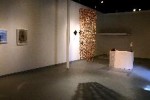Intelligent design

Tomato plants, human deformities and mold can all be found at the unique art exhibit being showcased at the William and Nancy Oliver Gallery. The show breathes life into the phrase ‘unconventional interdisciplinary art.’ Works of six USF artists – Taylor Robenalt, Maria Albornoz, Hiroki Haraguchi, André Collares, Kim Johnson and Kyle Smith – converge to present a truly spectacular show, Exploring Ideas, Interacting Spaces.
One of the most captivating pieces of art is the display by Collares. His works’ titles, such as “Asaphiscus wheeleri,” “Gasteracantha cancriformis” and “Ixodes ricinus,” will likely puzzle the observer unless he or she happens to be a mycologist. Using a distinctive style, Collares conveys his art through mold on acrylic sheets. The mold, grown using a gel media on a stencil, creates a thin, uneven layer, which the artist has laced with clean straight lines running across the layer. The sheer contrast between the sharp lines and the organic mold is evidently depicted through this “bio-art”.
As you glance around, Robenalt’s two trophy mounts on the wall meet the eye. The two heads, one canine and one human, have outward projections holding dog food and a cupcake for their respective consumers. Aptly titled “Pavlovian Conditioning,” the piece hints at the behavioral training that dogs and humans alike undergo.
“The title pokes fun at how not only dogs but also humans are conditioned,” Robenalt said. “I wanted the setting of the piece to be a trophy on the wall, but a silly one. The dog portrayed here is Smoker, my hairless pet dog that I bring around to the studio.”
Adding to Robenalt’s ceramics are other two works, “How Fragile It All Is” and “The Science of Calamity.” Using abstract imagery, both depict human resilience and the ability to rise above conflict and confusion. Her concept conveys teenage angst, overcoming depression and coming to terms with painful circumstances.
Explaining the placement of iridescent butterflies in the back of both the human head creations, Robenalt said: “Butterflies are just so visually appealing. They are so beautiful, so but fragile. Besides the aesthetic reasons, I put them there so that they bring you around the piece. The piece is no longer restricted to be viewed only from the front.”
Botanical contributions from Johnson are rooted in another corner in the gallery. The large potted plant standing alone attracts the onlooker to the title “Health Kick Hybrid Tomato (Class 4 Terminator).” Also quite elegant is “The Beginning of the End,” which showcases in 17 stages the process of a seed’s germination and its growth to green maturity. On an adjoining wall are Johnson’s pictures that illustrate a gardening documentary of genetically modified plants.
“The design of the garden is very symbolic,” said freshman Matt Dively. “The layout of the site has been set up in the shape of the biohazard sign, denoting the negative undertones associated with genetically modified plants.”
One cannot miss the significantly deformed human figure resting on the brownish-orange couch by a lampshade. A combination of rare genetic disorders is conceptually sculpted in the figure by Haraguchi. The piece has no limbs because of the congenital amputations that would be caused by Acheiropodia. Similarly, the malformations of the brain and intense abnormal development of facial structures are carved in to show the results of Holoprosencephaly.
“I am interested in the medical and biological sciences,” said Haraguchi. “It fascinates me how genes are passed from one generation to the other and so on. This way, genetic mutations also get passed on. Hundreds of them accumulate over time, and this burden manifests itself through severe deformities.”
Senior Ryann Slauson was amused by the novelty of Haraguchi’s deformed sculpture.
“I had never heard of these diseases,” Slauson said. “I thought it (was) based off of his idea, but these actually are diseases. His work has opened up something that is really new to me.”
This is the reaction that Haraguchi was hoping to get from the viewers about his artwork.
“I want them to question the reality of things,” he said. “How do such physical realities affect us mentally? I created this project through an investigation of my own self.”
About 260 squares, clay in nature, interlinked, form an artistic mesh that hangs down from the ceiling in the center of the gallery. “Beyond Appearances 1” is a part of Albornoz’s project focusing on a series of screens.
“This screen is sort of a window into another realm,” she said. “Clay is a passion of mine. Although it is hard to work with and it took a lot of time to build all these squares, I feel that the harder the work gets, the more interesting it becomes.”
But why squares?
“Having an architectural background, I’m fascinated by geometric shapes,” Albornoz said.
Her piece is intricately designed to coalesce the geometric squares with the organic clay. In its entirety, this carbon-covered, mobile mesh of clay squares has a characteristic rustic appeal.
The exhibition, in essence, is an apt personification of unorthodox and experimental methods. With marvelous contributions from all of the participating artists, it emphasizes the role of art as the medium to convey feelings, messages and thoughts.
“We want to show how important it is to make art, to get excited about going to a studio, and letting creativity take shape,” Robenalt said.
The reception for Exploring Ideas, Interacting Spaces will be held tonight from 7 – 9.






